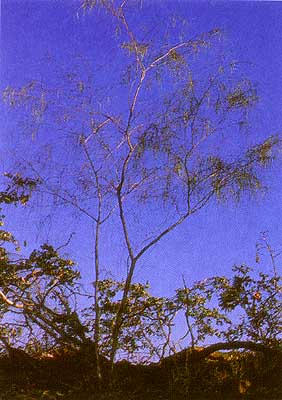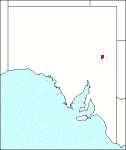Family: Fabaceae
Acacia araneosa

Citation:
D. J. E. Whibley, Contrib. Herb. Aust. 14:1(1976).
Derivation: araneosus (L.)—cobweb-like—refers to the cobwebby appearance of the tree because of the mesh of long fine branchlets and phyllodes.
Synonymy: Not Applicable Common name: spidery wattle, Balcanoona wattle
Description:
Small, erect, wispy trees 3-8 m high, cobwebby in appearance; trunks slender, 4-7 cm diam., solitary or dividing at about 1 m above ground level into two main branches; branches flexuose towards their apices; bark smooth, grey but becoming reddish-brown on young branchlets.
Phyllodes slender, 18-35 cm or sometimes to 69 cm long, 1-1.8 mm diam., pendulous, terete, but becoming almost tetragonous when dry, obscurely 4-veined, glabrous light green or sometimes scurfy, tapered at apex into non-pungent often recurved points; glands small, orbicular situated near phyllode base.
Inflorescences in axillary racemes which become paniculate at ends of branchlets due to phyllode reduction, racemes with 5-9 sparsely arranged heads; flower-heads globular, yellow, compact, 50-70-flowered; flowers 5-merous.
Legumes stipitate, linear, straight or slightly curved, 6-14.5 cm long, 4-6 mm broad, coriaceous, undulate, glabrous, olive green, becoming brown when mature; margins prominent vein-like somewhat contracted between the seeds. Seeds longitudinal or slightly oblique in legume; funicle slender extending ca. 3/4 the distance round the seed and terminating in a clavate aril.
|
|
Distribution:
|
Endemic to S.Aust., restricted to a small area in the Flinders Ranges region (northern part) from Nudlamutana Well near Balcanoona along the ranges to Arkaroola. Found on hillsides and ridges associated with Eucalyptus gillii and Triodia irritans in a dry open woodland. Just north of Nudlamutana Well a few dense stands of almost pure Acacia araneosa can be found with Triodia irritans as a ground cover. Soils; crusty alkaline neutral red duplex. Rainfall ca. 200 mm.
S.Aust.: FR.
|
Conservation status:
Lang & Kraehenbuehl (1987) consider this species Vulnerable.
Flowering time: Irregular periods throughout the year.
|

SA Distribution Map based
on current data relating to
specimens held in the
State Herbarium of South Australia
|
Biology:
No text
Related taxa:
Acacia rivalis (sp. 42) is closely related in flower and legume characters but differs in having flat, shorter phyllodes. Acacia juncifolia is similar in habit and phyllode characters but differs in flower and legume characters. It occurs in N T., Qld and N.S.W. but not in S.Aust. A. harveyi has flat phyllodes less than 10 cm long--endemic in Western Australia.
Cultivation:
From limited knowledge of this species in cultivation it seems that it could be a useful and unusual addition for ornamental planting. It prefers neutral to alkaline soils and good drainage. It has a very fast growth rate.
Author:
Not yet available
Source:

|

